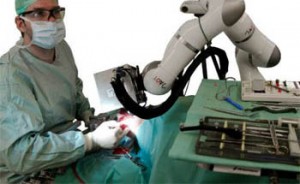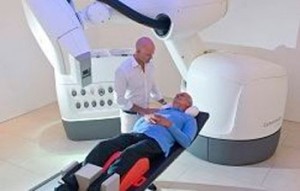AUTOMATICA – professional service robots
 Service robotics is revolutionizing medicine and healthcare; High-tech is providing more quality from surgery to rehabilitation. In the creation of diagnoses, for complicated surgical procedures as well as in everyday hospital work, service robots are becoming the perfect teammates of people. AUTOMATICA takes a look at the protagonists of a new era in Munich from June 21 to 24, 2016.
Service robotics is revolutionizing medicine and healthcare; High-tech is providing more quality from surgery to rehabilitation. In the creation of diagnoses, for complicated surgical procedures as well as in everyday hospital work, service robots are becoming the perfect teammates of people. AUTOMATICA takes a look at the protagonists of a new era in Munich from June 21 to 24, 2016.
Robots have many faces. As exoskeletons, they relieve workers as a stable outer shell when they lift and carry heavy objects. ReWalk Robotics applied this idea to quadriplegic people to enable them to walk again. The customized exoskeleton improves function, safety and alignment of joints. The patient can go for a walk, enter buildings without a ramp, hold conversations at eye level and is more independent. This affects his bone density and his body fat positively, improves posture and reduces pain; he is part of society again. The exoskeleton is also used in hospitals for exercises and therapy.
The precision of a service robot provides enormous benefits in surgery both for doctors and patients. CARLO (Computer Assisted, Robot-Guided Laser Osteotome) from Advanced Osteotomy Tools (AOT) is a pioneer in the operating room; it cuts bones contactless and carefully thanks to laser light. During this, sensors and the doctor control it continuously, which ensures safety and high-precision removal. “This means an optimal safety of the intervention and faster healing for the patient,” Dr Alfredo Bruno, CEO of AOT, explained.
Hope for cancer patients
Service robotics also enables gentle treatment in radiosurgery. For example, cyberknife technology developed at Stanford University treats tumors highly precisely to sub-millimetres using mobile robotics and digital imaging. “The treatment is given to people as outpatients and is painless; the surrounding tissue receives significantly less radiation, and an operation is unnecessary. The patient can usually resume his normal agenda immediately after treatment,” explained Professor Dr Alexander Muacevic from the European CyberKnife Center, which has already performed 6,000 such treatments successfully.
 Treating a patient in radiotherapy correctly and accurately is becoming increasingly trickier, because the number of recognized and treated structures is increasingly and they are increasingly fine.
Treating a patient in radiotherapy correctly and accurately is becoming increasingly trickier, because the number of recognized and treated structures is increasingly and they are increasingly fine.
With the positioning system from Buck Engineering and Consulting (BEC), patients can be positioned flexibly, aligned precisely and irradiated accurately. “The economic efficiency of the radiation source increases, which is a positive aspect for operators of radiotherapy centers and manufacturers of such equipment,” managing director Matthias Buck explained.
More care and attention in hospitals
Driverless transport systems are experiencing a boom. They take care of routine tasks for nurses around the clock. For those receiving care, this means more personal attention, optimal care and increased satisfaction. One example is the autonomous mobile delivery robot TUG from Aethon. In hectic hospital environments, it transports goods between pharmacy, laboratories, environmental services, food distribution, laundry service and blood bank.
BlueBotics developed the automatically controlled vehicle EVOcart for hospitals jointly with Oppent. Navigation is via laser scanning and requires no signs on the floor, walls or ceiling.
Visit the AUTOMATICA website for more information.
See all stories for AUTOMATICA















